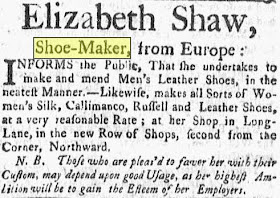 |
| Working on a pair of shoes at Eastfield Village. Photo by Rebecca of A Fashionable Frolic |
I love finding evidence of women in "non-traditional" trades. Shoe making in the 18th century, like many trades, was typically a trade for men. However, if one looks hard enough there is primary documentation for women working not only as shoemakers, but as stay makers, silversmiths, tinsmiths, and even blacksmiths. Some women even owned and ran their own shops. (See CW's article on women's trades here.)
Often times a master shoemaker would employee women to sew the uppers (the fabric portions) of shoes. This type of sewing didn't require any real knowledge of shoe making and could be done quickly and easily by anyone skilled with a needle and thread. In the case of Elizabeth Shaw, it would appear that that she was doing more then simple piece work.
Originally from Europe, Elizabeth is announcing to the public that she is setting up shop to make and mend men's and women's shoes "in the neatest Manner. ... at her Shop in Long Lane" The advertisement for Elizabeth's shop is dated July 20, 1767.
 |
| The Boston Post Boy & Advertiser, July 20, 1767 |
 |
| Red-pink glazed wool shoes, c. 1765 - Historic Deerfield |
 |
| Shoes, 1780-1790, Leather, linen, wool. These would have been "everyday" shoes for many English women. Snowshill Manor © National Trust / Richard Blakey |
Below is another map of Boston dated 1743. You can clearly see Long Lane (marked Long L.) in the lower left of the map.
 |
| Detail of 1743 map of Boston by William Price, showing the Financial District and vicinity |
This is what Long Lane looks like today.
 |
| Long Lane, now Federal Street in Boston's Financial District |
Random history facts of the day - Revolutionary War hero Henry Knox was
born in a house on Long Lane in 1750. And, in 1788, Long Lane was
renamed Federal Street.

Great post!
ReplyDeleteThanks! I've had that newspaper article saved for awhile now and finally got around to doing something with it.
ReplyDelete-Emily
That's you in the photo, right? LOVE the mix of patterns, fantastic outfit...and I think it's so neat that you get to re-enact some actual kind of work! I usually take some needlework to events but I don't think it's nearly as interesting to the public as watching an actual tradesman/woman.
ReplyDeleteHi Annabelle,
ReplyDeleteThanks! Yes that's me in the photo. It was taken last summer during the shoe making workshop I attended. The site wasn't open to the public but a couple of us that normally attend living history events decided to wear period attire. It was fun and really added to the experience.
I usually try to bring some kind of project with me to events. It's amazing to see how many people will stop and ask what you're working on. It's a great way to get the public engaged.
-Emily
Between you and MantuaDiary, shoemaking is starting to look like a fun new hobby to take up!
ReplyDeleteWonderful post! I was led here by the two nerdy history girls and I look forward to exploring your blog!
ReplyDeleteThank you ladies for your wonderful comments.
ReplyDelete-Emily